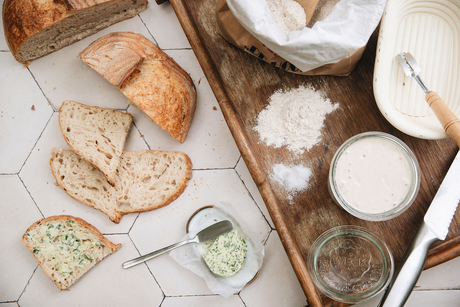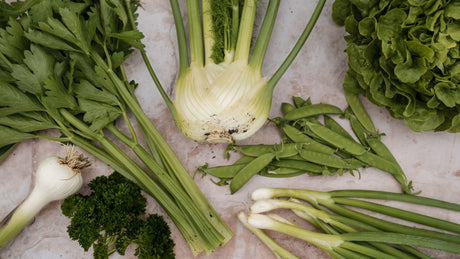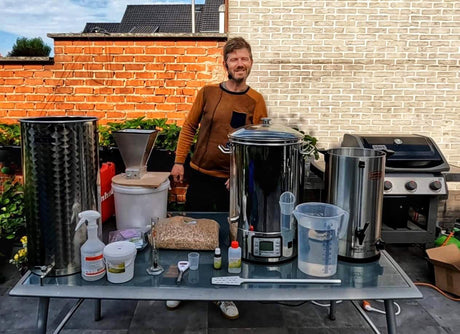Introduction
Welcome to our ultimate guide to help you create your own vegetable garden, your source of homegrown food that will bring you immense joy. Brace yourself, because in this article, I'll try to look at creating a vegetable garden from different perspectives. It won't be a short article, as I want to explain gardening in various ways, with one goal: everyone who reads this should start a vegetable garden.
In this post, I'm going to share five reasons why everyone should start a vegetable garden. Then I'll share three choices you need to make before your compost, spade, rake, or shovel hits the ground. These choices will help you avoid the mistakes I've seen or made myself. Once you've made those choices, I'll share all my "vegetable garden design tips." And once you've designed your vegetable garden and prepared the soil, I'll help you plan it.
I wish you much reading pleasure and a wonderful start to your vegetable garden.

Foreword: The 5 Ultimate Reasons That Convinced Me to Start a Vegetable Garden
5 reasons to start a vegetable garden? Our grandparents and their ancestors didn't ask this question. It was logical to grow your own vegetables. Had the internet existed in the pre-1960s and I been 50 years younger, the title of this article would have been: "What are the reasons not to have a vegetable garden?" After World War II, food was scarce, and everyone had a vegetable garden.

In the late 1950s, large department store chains like GB (Belgium) and Hema (Netherlands) emerged. Food no longer came from the vegetable garden but was available in the store. My parents married in 1962; both my father and mother come from families with a large vegetable garden. The whole family was involved in the garden; my uncles and aunts still talk about it. In our family (one generation later), we never grew a home-grown crop; we went to Maxi GB in Waregem... by car. As a child, I did remember the local farmer who came door to door with a large cart selling his seasonal vegetables.

He had a loudspeaker on his cart, advertising his vegetables in rhyming verses—it was delightful. All the women rushed out with their "wallets" under their arms and stood chatting around the "vegetable cart." Gradually, the rhyming greengrocer could no longer compete with the supermarkets due to the globalization of our economy. Better transportation, better technology, and better communication tools ensured that the loudspeaker on his "vegetable cart" finally fell silent...
Here are 5 reasons to have a vegetable garden, even if vegetables are in every store.
Reason 1: Vegetables that we grow ourselves in the vegetable garden taste better.
Why do our own vegetables taste better than store-bought ones? For me, the answer is a matter of several things.
A primary reason your own vegetables are delicious is their freshness and ripeness . This makes sense, as you're eating what's in season at the time. Vegetables or fruit you grow from seed are harvested ripe and, of course, incredibly fresh. The vegetable remains in the ground or on the plant until the very last moment. Studies show that homegrown vegetables contain more natural sugars and antioxidants. Vegetables grown for the supermarket are harvested before they're ripe and continue to ripen during transport or in large cold storage units where they're stored for later sale. Early-ripening vegetables are more bland.
What makes homegrown organic vegetables taste better is the nutrition . Organic fertilizer ( compost , humus, organic fertilizer pellets , etc.) contains far more minerals (calcium, magnesium , manganese, copper, iron, etc.), which are passed on to the plant. A traditional farmer sprays his land with herbicides every year and feeds his vegetables with artificial fertilizer. The focus here is on the size and weight of the vegetables rather than on flavor. Vegetables are usually sold by the gram (kilo), not by the unit of flavor. The food industry adapts to the profit that vegetables generate, even though profit is relative here. For industrially grown crops, farmers often still receive too little.
Mass producers don't always choose their varieties based on taste; logistical and financial interests often take precedence. Potatoes must be able to be transported for miles by truck, and cucumbers must fit in a wooden container with specific dimensions.


Reason 2: Starting a vegetable garden gives your body and mind strength
Organic gardening provides exercise. You choose the level of physical work you want. You can dig, but you can also use a spade or a motorized tiller. You can go all out with your garden hose and haul water, but you can also apply a mulch layer to reduce watering, or you can use a drip irrigation system. You're also often out and about with your wheelbarrow, so you can practically create your own fitness program in the vegetable garden. Growing your own food also gives us a great deal of satisfaction. Growing food is in our genes, and you feel that a healthy mind in a healthy body.
Reason 3: Growing your own vegetables is also about respect and education
How can you teach respect if you don't consciously know what you're eating? Developing respect for animals, vegetables, nature, food, and even people is difficult if you don't know what you're eating. What if you don't know how much energy goes into food? Children need to understand that food isn't something obvious on supermarket shelves. If you eat meat, you need to know that it's a deceased animal. With a vegetable garden, you teach your children that eating is something that requires attention and love. Besides math and language, every person should learn to grow food from kindergarten. Growing vegetables is biology, geography, history, management, and you learn a lot of social skills.

Reason 4: Creating a vegetable garden is making friends
In 2014, I started a larger vegetable garden a little further down my street. It's a long, narrow section that runs for 50 meters along a sidewalk. Children stand at the green fence and point out my chickens; if I'm on time, I give them a freshly laid egg. People stop to chat. Some even make a detour just for this. Everyone has a story about growing vegetables. "Back when we were little, we grew pumpkins on the dung heap..." a man who stopped on his bike told me. My Polish neighbor knows all the names of my vegetables and mows the weeds along my fence.

Through the Facebook group "Moestuin" ( vegetable garden), I met people in my neighborhood with whom I exchange tips, seeds , plants, and food. In times when we're increasingly focused on ourselves (and sometimes we can't help it), the vegetable garden is a bridge to being more social again. After work, my wife and I are tired. The gate closes, and we don't go outside anymore. But on Saturday mornings and beautiful spring and summer evenings, we head to the vegetable garden.
Reason 5 - Creating a vegetable garden is good for the environment

Recently, I saw a basil plant from Senegal in the supermarket. I thought basil came from Italy. Or better yet, I actually eat basil myself the moment it grows in my garden. Or in the winter, I take a shaker filled with home-dried basil. Full of heartfelt good intentions, you find tomato mozzarella with a fresh basil leaf on a skewer on the holiday snack trays. At a time when basil doesn't stand a chance in our climate. People are used to having fresh vegetables in the supermarket year-round. People who are in tune with nature and its seasons know better. Together, we can ensure we pollute much less. That we only have to travel 20 meters into the garden for a tomato from July to October, and that it doesn't have to be flown in from Morocco from November to June. That wastes energy. From our own vegetable garden near our home, we can contribute significantly to the major challenges facing our planet.
Starting your vegetable garden, first make 3 crucial choices



Option 1: Choose how big you want to start your vegetable garden
If you want to grow in the ground (not in pots or garden beds ), a vegetable garden of up to 25 m² is a feasible size. It's better to be proud of a small garden than to be frustrated and overwhelmed by a large one. Grow only what you like and no more crops than you can eat. If you have more space, consider perennials. These are plants that provide food or beautiful colors every year without too much work. Think of fruit trees , soft fruit , lavender, or tulip bulbs .
If you approach starting a vegetable garden wisely, you'll be amazed at how much food you can eat from your own garden. Read all about good planning here: Sowing Calendar vs. Harvest Calendar - Plan your vegetable garden carefully in 4 steps.
My vegetable garden grew from 20 m² in 2015 to 1100 m² in 2023. I started in 2016 with a 5 m² greenhouse under glass or plastic (see photo). Thanks to my passion for the vegetable garden and my business, I was able to install two more larger greenhouses in 2018 and 2023. The space grew along with the satisfaction I got from digging in the soil to grow my own food. That idea resonates deeply with who I am.
Option 2 if you want to start a vegetable garden: Choose the right location
Sometimes, due to lack of space, you have no choice, but if you can still make your own choices, I'd be happy to share my tips. A good spot for your vegetable garden is absolutely essential.
Choose a sunny spot to start your vegetable garden
Most vegetables need 6 to 8 hours of direct sunlight daily. A few vegetables (especially leafy greens) prefer shade.
- 3-4 hours of sun. This is the minimum! Leafy vegetables thrive in shade ( lettuce , head lettuce , lamb's lettuce , spinach , arugula, iceberg lettuce, etc.).
- 5-6 hours of sun. A good spot for root vegetables such as carrots , radishes , beets , onions , as well as potatoes and cabbage, in addition to leafy greens.
- 7-8 hours of sun. Ideal for growing fruit crops such astomatoes , peppers , squash , cucumbers , and also beans and flowers.
When planning your vegetable garden, choose a spot that is somewhat sheltered and not too windy:
Avoid areas exposed to strong winds. In a vegetable garden that isn't sheltered and exposed to unhindered wind, your soil will dry out faster. A strong wind can also blow over young plants or discourage pollinators, which help plants set fruit, from doing their work. You also don't want to plant in a spot that gets a lot of foot traffic or floods easily. Plant in a spot that would make Goldilocks smile—somewhere that's "just right."
If your vegetable garden has little or no fencing, you can choose to plant hedges or a row of low-stemmed fruit trees . If you have enough space, you can plant a hedge on the outside and place your fruit trees in front of it. But low-stemmed fruit trees alone also help significantly with windbreaks. This provides natural shelter and allows you to pick delicious fruit from your own garden.
Option 3: Starting a vegetable garden? Decide whether or not to improve your soil:
Good soil for your plants is like the shoes you wear. If they're too tight or too loose, walking isn't easy. Soil that's too compact will hinder the growth of your plants' root systems. In soil that's too loose, your plants' roots won't have enough room to settle, and water will drain too quickly.
If you have poorly drained and/or heavy soil (loam or clay) where water accumulates, it's better to start a raised bed garden. You can add a more airy soil there and mix it with the existing heavy garden soil for better drainage.
If there are a lot of stones in the soil, work the soil with a spade or pitchfork and remove them. These hinder root growth and generally make your plants less vigorous. A little stone here and there won't hurt, of course.
Earth, soil, your vegetable garden, ensuring sufficient aeration in your soil... it's quite complex. In my free e-book: FREE Organic Vegetable Garden E-book – Read the 5 Foundations of Your Vegetable Garden, I wrote everything you need to know about healthy soil in very simple terms. Starting a vegetable garden and successfully growing your first vegetables is so much easier when you know what's happening beneath the surface.

In this video I explain some things about soil preparation:
https://youtu.be/NByZ1mnvgSg?si=AEL8DvKR_tm4YxCp
Design the vegetable garden you want to start
Once you've decided on the location of your vegetable garden, you can start designing it. Will you choose open-field gardening? Or will you opt for raised beds or containers? And where should you place your paths, or should you pay attention to them? In this chapter, I'll try to answer these questions.
Designing a vegetable garden: Make sure everything is easily accessible
No matter how large your garden is, make sure you have easy access to everything so you can comfortably weed, care for your plants, and, of course, harvest. Make sure you can easily reach the center of your vegetable bed without stepping on the ground. Generally, a vegetable bed is rectangular and about 1.25 meters wide. Ideally, a vegetable bed should be no longer than 5 meters. This allows you to work conveniently in your vegetable garden without having to constantly walk long distances when harvesting or weeding, for example.
Paths are indispensable in the design of your vegetable garden
To easily access your vegetable garden beds, you'll also need paths. If you're limited on space, paths might be the first thing you want to save. Don't be fooled, paths make everything in your garden easy to reach. Consider the width of your wheelbarrow or lawn mower when choosing where to place your paths. This ensures you can easily reach everything with your wheelbarrow. This is ideal if you want to harvest larger quantities of vegetables like potatoes, or if you want to apply compost in spring or autumn. A standard path is approximately 50 cm wide.
Determine the number of vegetable garden beds in your design
How many beds will your vegetable garden consist of? The answer to this question depends on how you intend to garden. Each plant absorbs different nutrients from the soil and returns different elements to the soil.










